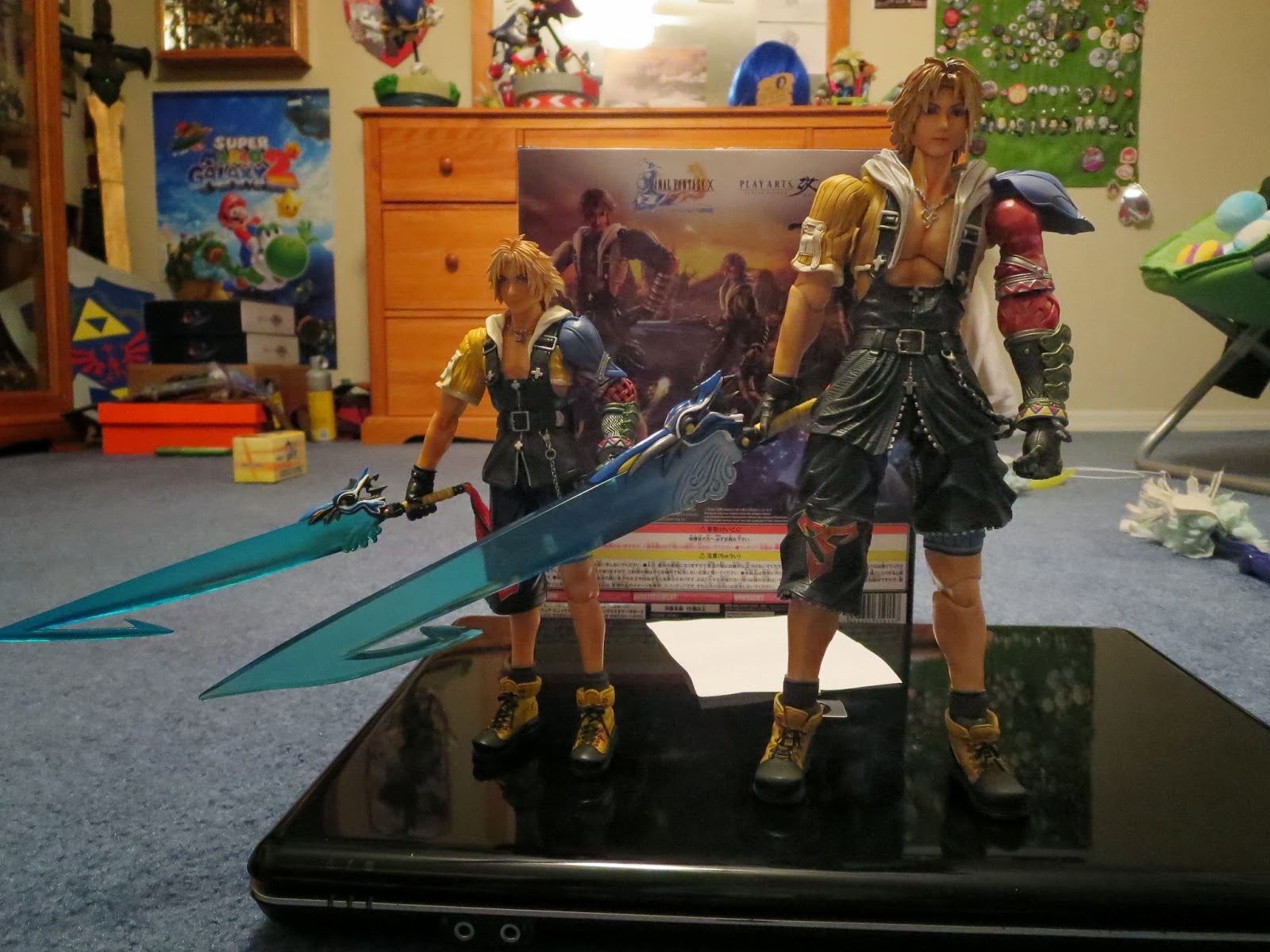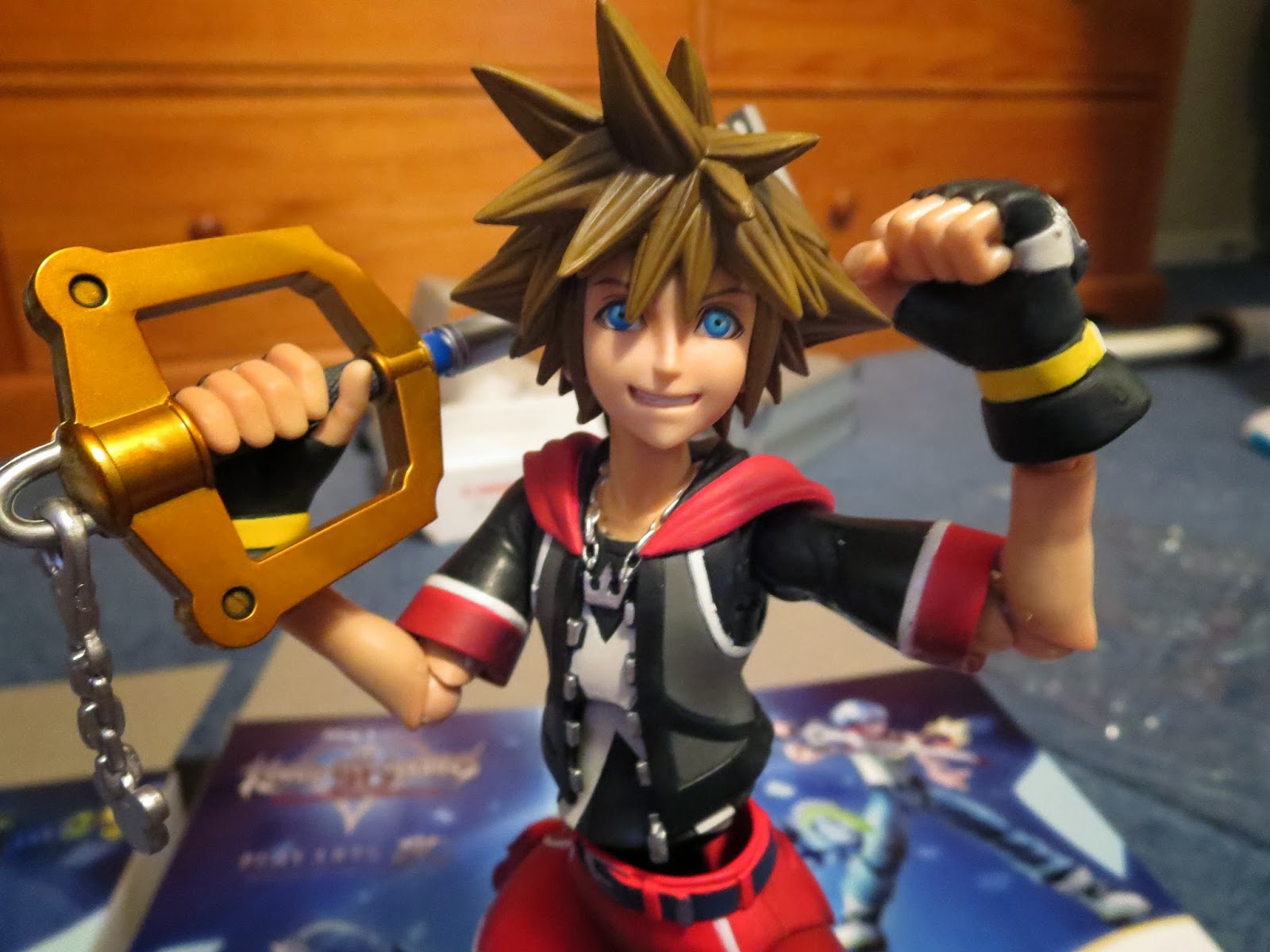"Listen to my story.
This… may be our last chance." ~Tidus, Final Fantasy X
Please enjoy listening to this nostalgic music as you read this review.
Please enjoy listening to this nostalgic music as you read this review.
Packaging: Following the new Kai Arts packaging, both Tidus
and Yuna come in detailed, colorful boxes with snap-open Velcro clasps. The box
art is gorgeous and attractive. The insides contain explanations on the
characters and series (reminiscent of the narrator in Dissidia, if you ask me). Props on the packaging, SQUARE!
Paint job: Really lovely, especially when you compare them
to their previous figurine releases. For example, Tidus has much more shading
this time around, which gives him a more realistic, dramatic look. The skin
tone has multiple shades to it, which is much more attractive than the single color
used in the first Play Arts line. I noticed just one or two very minor paint
smudges. The paint job gives an impression of maturity, as these figures are
becoming more lifelike in their details.
 |
| The new Play Arts Kai Tidus (right) next to the older, original Play Arts model (left) |
Articulation: Tidus boasts of very thorough articulation. In
fact, the only two areas that are not flexible are his hips and his left wrist,
which is restricted by sturdy upper-arm armor. Otherwise, almost all other
locations are flexible—neck, shoulders, chest, legs, ankles, bottom of the
shoes, shoulder guard, etc. Admittedly, the chest rotation looks slightly
awkward as it misaligns his vest straps.
Yuna is more restrictive. While still graced with a
reasonable flexibility, her legs in particular seem to suffer. Unlike Tidus,
the bottom of her boots is not a separate piece, and there is no side-to-side
movement allowed by the ball joints in the ankles. Because of this, getting
Yuna to stand up (especially if you get a figure with a slightly crooked shoe
base) can be a bit tricky without a stand. The wide sleeves of her garb
sometimes restrict how much her hands are able to turn at the wrists as well.
Accessories: Tidus comes with Brotherhood (which is almost as tall as he is), his Blitzball, an
exchangeable face with the eyes closed, and three additional hands: (1) an open
palm for holding the Blitzball, (2) a gripping hand for holding the sword, and
(3) a slightly open hand for simple visual diversity.
Yuna comes with a slightly more modest variety: two open
hands, an interchangeable face with the eyes closed, and her rod. She arrives
with her closed-fist and staff-holding hands attached.
The figures each come with the new Kai Arts line stands.
These new stands are bulky and transparent. They require assembling and, from
my personal experience, just aren’t as effective as the classic
black-stands-with-metallic-cinches were. They’re a hassle to put together and
they take up a large area of your shelf. The figures can balance just fine
without the stands, fortunately, making the stands pretty unnecessary for these
two (unless you want to give them a very dynamic or unbalanced pose).
Negatives: Tidus’ sword-holding hand is loose, which on the
one hand makes it easy to slide the sword into his grasp, but on the other hand
makes it easy for the sword to slip back out again. Certain areas are not
flexible, particularly the left wrist. His necklace and pendant are sculpted
directly into his neck, unlike the previous Tidus figure, whose pendant hung loosely
from his neck by a delicate chain. Something about the proportions between his
head, neck, and chest seem a bit… off… but perhaps this is due to the fact that
the open vest makes his neck look longer. Lastly, he can only hold his props in
his right hand, meaning that you can’t pose him to hold both the sword and the
Blitzball simultaneously.
Yuna suffers from some inflexibility in her boots, which can
make posing her slightly difficult. The fingers on her open hands are very
delicate and should be handled with caution. The wide sleeves of her garb can restrict
the rotation of her wrists.
Overall: Rejoice, fans of Final Fantasy X—these are the figures you’ve been waiting for!
SQUARE is kicking off the release of Final
Fantasy X HD in style, and these figurines are the perfect way to
commemorate your love for the occasion. Giving these figures an overall rating
is difficult. In comparison to their previous Play Arts figures, this newer
Tidus and Yuna truly shine with more articulation, a better sculpt, more
realistic shading, plenty of accessories, and a snazzy paint job to top it all
off.
As independent figures, these two lovebirds are impressive
pieces to add to your collection. Due to some of the negatives listed above,
however, they aren’t flawless. For the fan, the imperfections won’t matter,
though. You’ll be too busy reliving nostalgic memories of Spira and the tears
you shed during that last, glorious CGI cutscene.
I’m proud to give the new Tidus and Yuna Play Arts Kai
figurines 4 out of 5 stars.

You might also like:






































